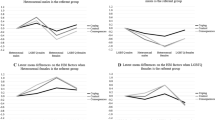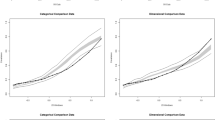Abstract
Hypersexual Disorder is currently being considered for inclusion in the DSM-5. To inform this process, we investigated the latent structure of the hypersexuality construct using Meehl’s (1995) taxometric method. Data on sexual interests and behaviors were obtained from 2,101 general population males and females in Sweden and 716 male sex offenders from the United States. Taxometric analyses of self-report indicators of hypersexuality supported a dimensional interpretation of latent structure in both samples. These findings suggest that individual differences in hypersexuality are quantitative (matter of degree) rather than qualitative (difference in kind) in nature, at least when self-report data were used. This is another way of saying that hypersexuality is organized along a continuum of increasing sexual frequency and preoccupation, with clinical cases of hypersexuality falling at the upper end of the continuum or dimension. We conclude that the proposed inclusion of Hypersexual Disorder in the DSM-5 should acknowledge the lack of non-arbitrary breaks in the latent symptoms continuum which runs from very low to very high engagement in sexual behavior and preoccupation. The diagnostic threshold should therefore be decided from an analysis of external data on severity, comorbidity, and prognosis for individuals with sub-threshold and full diagnoses, respectively. Additionally, dimensional assessment of Hypersexual Disorder should be part of clinical diagnostic practice.






Similar content being viewed by others
References
Arntz, A., Bernstein, D., Gielen, D., van Nieuwenhuyzen, M., Penders, K., Haslam, N., et al. (2009). Taxometric evidence for the dimensional structure of cluster C, paranoid, and borderline personality disorders. Journal of Personality Disorders, 23, 606–628.
Bancroft, J. (1999). Central inhibition of sexual response in the male: A theoretical perspective. Neuroscience and Biobehavioral Reviews, 23, 763–784.
Bartlett, M. S. (1937). The statistical conception of mental factors. British Journal of Psychology, 28, 97–104.
Black, D. W. (2000). The epidemiology and phenomenology of compulsive sexual behavior. CNS Spectrums, 5, 26–72.
Blanchard, J. J., Horan, W. P., & Collins, C. M. (2005). Examining the latent structure of negative symptoms: Is there a distinct subtype of negative symptom schizophrenia? Schizophrenia Research, 77, 151–165.
Carnes, P. (1983). Out of the shadows: Understanding sexual addiction. Minneapolis, MN: CompCare.
Coleman, E. (1990). The obsessive-compulsive model for describing compulsive sexual behavior. American Journal of Preventive Psychiatry and Neurology, 2, 9–14.
Daversa, M., & Knight, R. A. (2007). A structural examination of the predictors of sexual coercion against children in adolescent sexual offenders. Criminal Justice and Behavior, 34, 1313–1333.
Edens, J. F., Marcus, D. K., & Ruiz, M. A. (2008). Taxometric analyses of borderline personality features in a large-scale male and female offender sample. Journal of Abnormal Psychology, 117, 705–711.
Frazier, T. W., Youngstrom, E. A., Sinclair, L., Kubu, C. S., Law, P., Rezai, A., … et al. (2010). Autism spectrum disorders as a qualitatively distinct category for typical behavior in a large, clinically ascertained sample. Assessment, 17, 308–322.
Green, B. A., Ahmed, A. O., Marcus, D. K., & Walters, G. D. (2011). The latent structure of alcohol use pathology in an epidemiological sample. Journal of Psychiatric Research, 45, 225–233.
Kafka, M. P. (1997). Hypersexual desire in males: An operational definition and clinical implications for males with paraphilias and paraphilia-related disorders. Archives of Sexual Behavior, 26, 505–526.
Kafka, M. P. (2001). The paraphilia-related disorders: A proposal for a unified classification of nonparaphilic hypersexuality disorders. Sexual Addiction and Compulsivity, 8, 227–239.
Kafka, M. P. (2003). Sex offending and sexual appetite: The clinical and theoretical relevance of hypersexual desire. International Journal of Offender Therapy and Comparative Criminology, 47, 439–451.
Kafka, M. P. (2007). Paraphilia-related disorders: The evaluation and treatment of nonparaphilic hypersexuality. In S. Leiblum (Ed.), Principles and practice of sex therapy (4th ed., pp. 442–476). New York: Guilford.
Kafka, M. P. (2010). Hypersexual disorder: A proposed diagnosis for DSM-V. Archives of Sexual Behavior, 39, 377–400.
Kafka, M. P., & Hennen, J. (1999). The paraphilia-related disorders: An empirical investigation of nonparaphilic hypersexuality disorders in outpatient males. Journal of Sex and Marital Therapy, 25, 305–319.
King, M. W. (2010). Neurodevelopmental vulnerability for pedophilia: A taxometric investigation of its latent structure. Dissertation Abstracts International: Section B. Sciences and Engineering, 71(8).
Kingston, D. A., & Firestone, P. (2008). Problematic hypersexuality: A review of conceptualization and diagnosis. Sexual Addiction and Compulsivity, 15, 284–310.
Knight, R. A., & Cerce, D. D. (1999). Validation and revision of the Multidimensional Assessment of Sex and Aggression. Psychologica Belgica, 39, 187–213.
Knight, R. A., & King, M. W. (in press). Typologies for child molesters: The generation of a new structural model. In B. K. Schwartz (Ed.), The sexual offender (Vol. 7). Kingston, NJ: Civic Research Institute, Inc.
Knight, R. A., Prentky, R. A., & Cerce, D. D. (1994). The development, reliability, and validity of an inventory for the Multidimensional Assessment of Sex and Aggression. Criminal Justice and Behavior, 21, 72–94.
Knight, R. A., Ronis, S. T., Prentky, R. A., & Kafka, M. (2010). The role of sexual motivation in sexually coercive behavior. Manuscript submitted for publication.
Knight, R. A., & Sims-Knight, J. E. (2003). The developmental antecedents of sexual coercion against women: Testing alternative hypotheses with structural equation modeling. Annals of the New York Academy of Sciences, 989, 72–85.
Knight, R. A., & Sims-Knight, J. E. (2004). Testing an etiological model for juvenile sexual offending against women. Journal of Child Sexual Abuse, 13, 33–55.
Kraemer, H. C. (2008). DSM categories and dimensions in clinical and research contexts. In J. E. Helzer, H. C. Kraemer, R. F. Krueger, H. Wittchen, P. J. Sirovotka, & D. A. Regier (Eds.), Dimensional approaches in diagnostic classification: Refining the research agenda for DSM-V (pp. 5–17). Washington, DC: American Psychiatric Publishing.
Långström, N., & Hanson, R. K. (2006). High rates of sexual behavior in the general population: Correlates and predictors. Archives of Sexual Behavior, 35, 37–52.
Långström, N., & Seto, M. C. (2006). Exhibitionistic and voyeuristic behavior in a Swedish national population survey. Archives of Sexual Behavior, 35, 427–435.
Långström, N., & Zucker, K. J. (2005). Transvestic fetishism in the general population: Prevalence and correlates. Journal of Marital Therapy, 31, 87–95.
Laumann, E. O., Gagnon, J. H., Michael, R. T., & Michaels, S. (1994). The social organization of sexuality: Sexual practices in the United States. Chicago: University of Chicago Press.
Longley, S. L., Broman-Fulks, J. J., Calamari, J. E., Noyes, R., Wade, M., & Orlando, C. M. (2010). A taxometric analysis of hypochondriasis symptoms. Behavior Therapy, 41, 505–514.
Marcus, D. K., & Barry, T. D. (in press). Does Attention-Deficit/Hyperactivity Disorder have a dimensional latent structure? A taxometric analysis. Journal of Abnormal Psychology.
Maser, J. D., & Patterson, T. (2002). Spectrum and nosology: Implications for DSM-V. Psychiatric Clinics of North America, 25, 855–885.
Meehl, P. E. (1992). Factors and taxa, traits and types, differences of degree and differences in kind. Journal of Personality, 60, 117–174.
Meehl, P. E. (1995). Bootstraps taxometrics: Solving the classification problem in psychopathology. American Psychologist, 50, 266–275.
Meehl, P. E. (2004). What’s in a taxon? Journal of Abnormal Psychology, 113, 39–43.
Meehl, P. E., & Yonce, L. J. (1994). Taxometric analysis: I. Detecting taxonicity with two quantitative indicators using means above and below a sliding cut (MAMBAC procedure). Psychological Reports, 74, 1059–1274.
Meehl, P. E., & Yonce, L. J. (1996). Taxometric analysis: II. Detecting taxonicity using covariance of two quantitative indicators in successive intervals of a third indicator (MAXCOV procedure). Psychological Reports, 78, 1091–1227.
MIDSA Clinical Manual. (2008). Bend, OR: Augur Enterprises. Retrieved March 15, 2010, from www.midsa.us.
Rawlings, D., Williams, B., Haslam, N., & Claridge, G. (2008). Taxometric analysis supports a dimensional latent structure for schizotypy. Personality and Individual Differences, 44, 1640–1651.
Ruscio, J. (2007). Taxometric analysis: An empirically-grounded approach to implementing the method. Criminal Justice and Behavior, 34, 1588–1622.
Ruscio, J. (2008) Taxometric programs for the R computing environment: User’s manual. (http://www.taxometricmethod.com). Accessed June 12, 2008.
Ruscio, J., Haslam, N., & Ruscio, A. M. (2006). Introduction to the taxometric method: A practical guide. Mahwah, NJ: Lawrence Erlbaum.
Ruscio, J., & Marcus, D. K. (2007). Detecting small taxa using simulated comparison data: A reanalysis of Beach, Amir, and Bau’s (2005) data. Psychological Assessment, 19, 241–246.
Ruscio, J., Ruscio, A. M., & Meron, M. (2007). Applying the bootstrap to taxometric analysis: Generating empirical sampling distributions to help interpret results. Multivariate Behavioral Research, 42, 349–386.
Ruscio, J., & Walters, G. D. (2009). Using comparison data to differentiate categorical and dimensional data by examining factor score distributions: Resolving the mode problem. Psychological Assessment, 21, 578–594.
Ruscio, J., Walters, G. D., Marcus, D. K., & Kaczetow, W. (2010). Comparing the relative fit of categorical and dimensional latent variable models using consistency tests. Psychological Assessment, 22, 5–21.
Shadish, W. R., Cook, T. D., & Campbell, D. T. (2002). Experimental and quasi-experimental designs for generalized causal inference. Boston: Mifflin.
Slade, T., & Grisham, J. R. (2009). A taxometric investigation of agoraphobia in a clinical and a community sample. Journal of Anxiety Disorders, 23, 799–805.
Solomon, A., Ruscio, J., Seeley, J. R., & Lewinsohn, P. M. (2006). A taxometric investigation of unipolar depression in a large community sample. Psychological Medicine, 36, 973–985.
Træen, B., Spitznogle, K., & Beverfjord, A. (2004). Attitudes and use of pornography in the Norwegian population 2002. Journal of Sex Research, 41, 193–200.
Wakefield, J. C. (1992). The concept of mental disorder: On the boundary between biological facts and social values. American Psychologist, 47, 373–388.
Waller, N. G., & Meehl, P. E. (1998). Multivariate taxometric procedures: Distinguishing types from continua. Thousand Oaks, CA: Sage.
Walters, G. D. (2008). The latent structure of alcohol use disorders: A taxometric analysis of structured interview data obtained from male federal prison inmates. Alcohol and Alcoholism, 43, 326–333.
Walters, G. D. (2009). Latent structure of a two-dimensional model of antisocial personality disorder: Construct validation and taxometric analysis. Journal of Personality Disorders, 23, 647–660.
Walters, G. D. (2010). Dementia: Continuum or distinct entity? Psychology and Aging, 25, 534–544.
Walters, G. D., McGrath, R. E., & Knight, R. A. (2010). Taxometrics, polytomous constructs, and the comparison curve fit index: A Monte Carlo analysis. Psychological Assessment, 22, 149–156.
Walters, G. D., & Ruscio, J. (2009). To sum or not to sum: Taxometric analysis with ordered categorical assessment items. Psychological Assessment, 21, 99–111.
Walters, G. D., & Ruscio, J. (2010). Where do we draw the line? Assigning cases to subsamples for MAMBAC, MAXCOV, and MAXEIG taxometric analyses. Assessment, 17, 321–333.
Winters, J. (2010). Hypersexual disorder: A more cautious approach [Letter to the editor]. Archives of Sexual Behavior, 39, 594–596.
Zakireh, B., Ronis, S. T., & Knight, R. A. (2008). Individual beliefs, attitudes, and victimization histories of male juvenile sexual offenders. Sexual Abuse: A Journal of Research and Treatment, 20, 323–351.
Acknowledgments
Niklas Långström is a member of the Paraphilias Sub-workgroup of the DSM-5 Sexual and Gender Identity Disorders Work Group and Raymond Knight is an advisor to that group. The assertions and opinions contained herein are the private views of the authors and should not be construed as official or as reflecting the views of the Federal Bureau of Prisons or the United States Department of Justice.
Author information
Authors and Affiliations
Corresponding author
Rights and permissions
About this article
Cite this article
Walters, G.D., Knight, R.A. & Långström, N. Is Hypersexuality Dimensional? Evidence for the DSM-5 from General Population and Clinical Samples. Arch Sex Behav 40, 1309–1321 (2011). https://doi.org/10.1007/s10508-010-9719-8
Received:
Revised:
Accepted:
Published:
Issue Date:
DOI: https://doi.org/10.1007/s10508-010-9719-8




